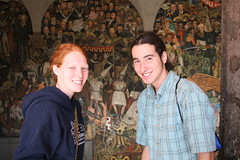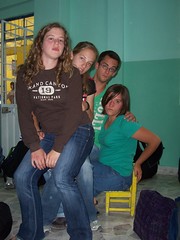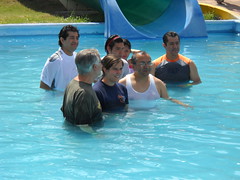 It is hard to describe in full what we did on our weekend in the Federal District, which is more commonly known as Mexico City, but I will try briefly to describe to you some of the places we visited.
It is hard to describe in full what we did on our weekend in the Federal District, which is more commonly known as Mexico City, but I will try briefly to describe to you some of the places we visited.
For many of us, who are not city people by any means, the idea of going to one of the largest cities in the world seemed more daunting than exciting. However, my presumptions proved wrong for I had multiple rewarding experiences on this weekend trip in the city. We visited many places including Teotihuacan, the Basilica de Guadalupe, and the National Palace among some of the destinations, but none were more fascinating to me than the Ballet Folklorico. Now don’t let the name ballet fool you. The Ballet Folklorico is for both men and women alike and is not intended for the aristocracy. Instead, the Ballet Folklorico was truly an amazing and unique cultural experience that I am very pleased to have experienced. The show’s purpose is to preserve the many unique styles of dances found across Mexico and to present them to the general public. This performance is usually held in the Bellas Artes theater house, but due to renovations, the dance was held in the Museum of Anthropology’s theater. Although it was held in a different location it was still a breathtaking experience none the less.
 One cannot simply sit down and describe to you the performance with words alone. Indeed I hope not to do the show injustice for attempting to explain through words alone for one can only truly appreciate and understand the show if you see it with your own eyes.
One cannot simply sit down and describe to you the performance with words alone. Indeed I hope not to do the show injustice for attempting to explain through words alone for one can only truly appreciate and understand the show if you see it with your own eyes.
Every region of Mexico has a different style of dance, music, and type of clothing so that everyone was intrigued with the performances. Each dance was unique in itself and the variety of colorful clothing and styles of music was truly pleasing to the senses. We sat in the front row and were so close to the dancers that one was able to feel the movement of air as a dancer passed by and one could even smell the different perfumes or colognes of the dancers. And, if one was fortunate enough, one could even make eye contact and exchange smiles with the dancers.
Most of the dances centered around one of the following themes: love, hunting, and/or conflict. There were around ten different acts, each from a different part of Mexico. My personal favorite was the dance entitled Danza del Venado or ‘The Deer Dance’ in English. This dance is from the Yaqui people who still live apart from modern society and continue to hunt with bows and arrows. The Yaqui dance celebrates the life of a deer by portraying the final minutes of a majestic stag’s life, which is represented by a man wearing a hat with a deer’s head. The deer pranced around the stage for some time to the tribal drums beating in the background. Eventually, two Yaqui hunters came onto the stage and proceeded to shoot the majestic deer. As the stag began to die the drums started to slow down and one would realize the drums are supposed to represent the deer’s heartbeat. When the drums stopped beating, the deer finally died. This moving act was truly a unique experience that I was thrilled to have witnessed.
– Austin Shenk
 On Friday March 26, the only thing on anyone’s mind was the bull fight that we were going to watch that night. I was particularly excited to go to the bull fight. After reading “Mexico” by James A. Michener, I felt like I knew everything I needed to know for the bull fight. Once we got to the stadium, I quickly realized how wrong I was. There were so many things going on at once that I had to keep asking Sonnie and Amy what was going on. Despite the confusion, I felt like I was able to appreciate the whole experience more. The book “Mexico” made me realize just how dangerous this sport really is.
On Friday March 26, the only thing on anyone’s mind was the bull fight that we were going to watch that night. I was particularly excited to go to the bull fight. After reading “Mexico” by James A. Michener, I felt like I knew everything I needed to know for the bull fight. Once we got to the stadium, I quickly realized how wrong I was. There were so many things going on at once that I had to keep asking Sonnie and Amy what was going on. Despite the confusion, I felt like I was able to appreciate the whole experience more. The book “Mexico” made me realize just how dangerous this sport really is.
The matadors were everything I was expecting them to be. Their bright colored costumes were fun to watch as they sparkled in the light when the bulls ran past them. Each Matador went one at a time and they all got two bulls each. The second Matador is a famous matador from Spain, so he got a third bull at the end. He was my favorite matador out of the three. We left before he finished his third bull, but we were able to see the most exciting part of the whole performance. The last bull jumped the fence and started running around in the audience. The staff workers were able to quickly get the bull back in to the arena before anyone got hurt. It was the thrill that I had been waiting to see. After this I didn’t want to leave, but it was already 11 pm and everyone was tired. If I had another chance to go again, I would. The smoke and the crowds were well worth the experience. If you have a weak stomach for animals then I would not recommend this for you. For everyone else, if you get a chance to see a matador go up against an angry bull, then I recommend you go. And take me with you.
– Jerica Martin
 This past week was Holy Week, and we spent the week with a Mennonite church in Mexico City. We did a variety of things around the city, like visiting one of the largest universities in the world, and going to Chapultepec and spending some time at a zoo, castle, or just wondering around. We painted the church, which was an all day project. In the evenings we spent time with our host families, talking with them or going to various places.
This past week was Holy Week, and we spent the week with a Mennonite church in Mexico City. We did a variety of things around the city, like visiting one of the largest universities in the world, and going to Chapultepec and spending some time at a zoo, castle, or just wondering around. We painted the church, which was an all day project. In the evenings we spent time with our host families, talking with them or going to various places.
The church had services almost every day because it was Holy Week, and we participated, singing in some of them. On Thursday night we had the Last Supper and footwashing. I really enjoyed this part, and seeing the interactions between two very different groups of people. It was amazing to see how we could cross cultural barriers and connect with each other by the simple act of washing someone else’s feet. On Friday we went into town to watch re-enactments of Jesus’ trial and crucifixion. This was very different from what we’ve ever experienced on Good Friday, because we saw in real life what actually happened. Saturday we went to a water park where we had baptisms, including Sara from our group. Following this we went to Tula, some ruins. One thing that stuck out to me this week was how we affected the people in the church. We had gone to serve them, especially by painting their church, but at the same time they were there to serve us. Since this was Holy Week, most of them had off from work, and they basically spent the whole week with us. Almost all of our meals were at the church, so they had to prepare large amounts of food. Anytime we went out into the city a group of them would accompany us. Many of them opened their homes so we would have a place to stay for the week. It was a blessing for them to be able to spend time with us, and build friendships. We had gone expecting to serve them and take part in their Holy Week celebrations, but I think that they served us more, and were very glad to do so.
Friday, because we saw in real life what actually happened. Saturday we went to a water park where we had baptisms, including Sara from our group. Following this we went to Tula, some ruins. One thing that stuck out to me this week was how we affected the people in the church. We had gone to serve them, especially by painting their church, but at the same time they were there to serve us. Since this was Holy Week, most of them had off from work, and they basically spent the whole week with us. Almost all of our meals were at the church, so they had to prepare large amounts of food. Anytime we went out into the city a group of them would accompany us. Many of them opened their homes so we would have a place to stay for the week. It was a blessing for them to be able to spend time with us, and build friendships. We had gone expecting to serve them and take part in their Holy Week celebrations, but I think that they served us more, and were very glad to do so.
Overall it was an excellent week, and we all thoroughly enjoyed it all. By the end none of us wanted to leave, because we had made such strong connections with the people in the church. The last day we were sad as we were taking pictures and saying goodbye.
– Allison Sherer
 Semana Santa – Holy Week. The time of year when we celebrate one man’s death. Pretty exciting, right? Heck yes it is! At least when that man happens to be the Son of God. And especially when He doesn’t stay dead. No, indeed He is risen.
Semana Santa – Holy Week. The time of year when we celebrate one man’s death. Pretty exciting, right? Heck yes it is! At least when that man happens to be the Son of God. And especially when He doesn’t stay dead. No, indeed He is risen.
The past week happened to be no less than amazing. Many things could be said about it. But the reenactment of the moments leading up to and culminating in Jesus’ death stand out clearly as one of the highlights of the week. So let me ask you something before I continue. How many times have you read the story of Jesus’ crucifixion? Probably too many. Why? It’s easy to forget what really happened and read with indifference the words “Pilate handed him over to be flogged” and “They crucified Him.” Do you realize what Jesus had to go through to save the world from their sin? DEATH! And not just death, PAIN! Pain so painful He was literally sweating blood before it all really even started, not to mention the nails piercing the nerves in His hands and virtually no more skin left on His back after the floggings. Surely we must not forget SO GREAT A SALVATION! Indeed He is risen.
One thing’s for sure – the Mexicans here sure know how to do a reenactment. Ya ain’t gonna see this in North Dakota! Complete with a “real” crown of thorns and “real” blood. The Roman soldiers actually flogged Jesus in the reenactment. Though it was with whips that were just made of rope, it still had to hurt. The soldiers yanked Jesus around like he was a dog, spat on him, and kicked one of his followers off of the stage. In the procession that followed Jesus’ sentencing, where Jesus and the two other prisoners carried their crosses to “Golgotha,” the Roman soldiers continually whipped the cross-bearers (though they stopped to rest a few times and make sure the people were actually okay). I have never seen a more accurate account of what actually happened to Jesus (at least concerning the violence) other than “The Passion.” I think the scariest part of the reenactment, however, had to be when the Romans put the crown of thorns on Jesus. The crown looked extremely real, and when they shoved it down on his head, blood dripped down his face. Thankfully, we found out later that it was indeed fake blood.
So was Jesus’ death in real life this bad? No, it was much worse. They didn’t care to stop on the way to Golgatha to make sure Jesus had enough water, and they didn’t care to use fake blood. Jesus actually died, and you can rest assured it was painful beyond what any of us have felt. But what happened three days later makes Jesus’ death a wonderful, joyful thing. Praise God! INDEED HE IS RISEN!
-Cody Stutzman